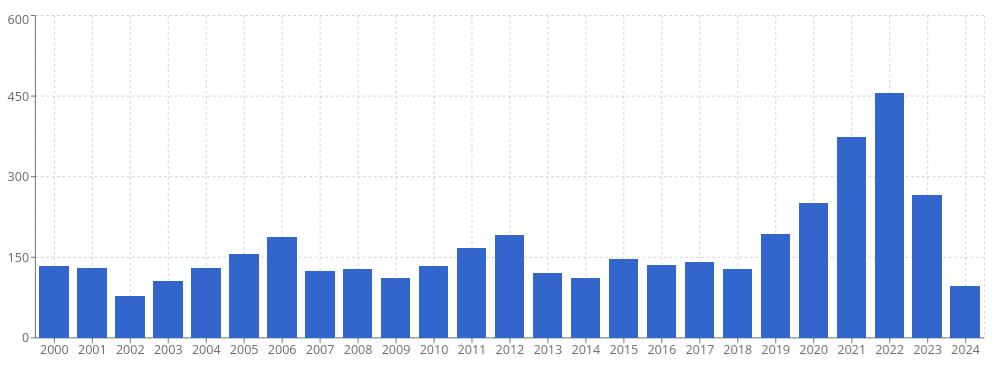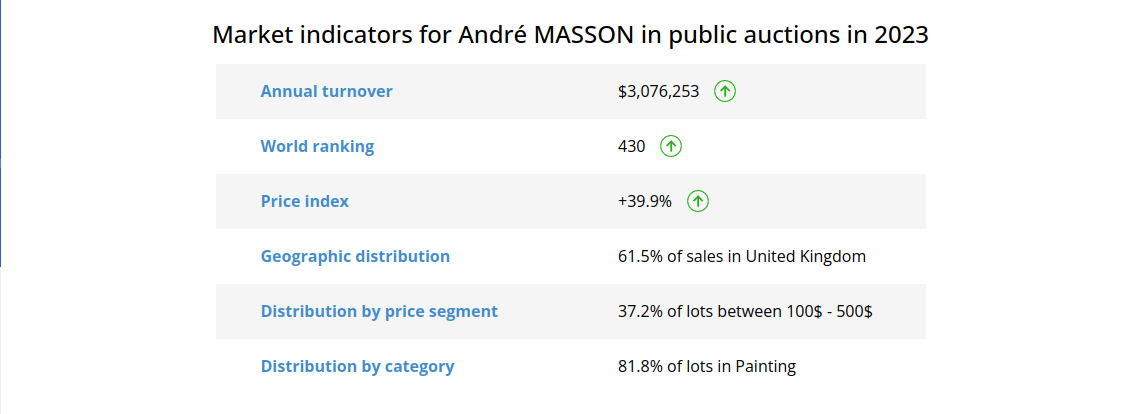André Masson at the Centre Pompidou-Metz for the centenary of Surrealism
[28 May 2024]André Masson was one of the greatest painters of the 20th century recalls Chiara Parisi, curator of the current exhibition at the Centre Pompidou-Metz, of which she is the director.
On the occasion of the centenary of the first Surrealist Manifesto, Chiara Parisi revives the memory of a versatile artist who was creative with sculpture, scenography, writing and poetry. André MASSON, a free and rebellious spirit endowed with an encyclopedic culture, deeply believed that the only justification of a work of art is to contribute to the spiritual broadening of the human being, to the transmutation of all values, to the denunciation of social, moral and religious hypocrisy, and consequently to the denunciation of the dominant class, responsible for the imperialist war and the fascist regression (Chiara Parisi).
His first erotic drawings, produced a few years after the First World War, gave way, in the early 1920s, to experiments which had a major influence on other creators, particularly in the United States. Indeed, his works marked the very beginnings of American Abstract Expressionism.
In May 1941, Masson arrived in New York and settled near Alexander CALDER. Among other European exiles, he frequented André Breton, Arshile Gorky and Marc Chagall. His work, as well as his lectures, immediately influenced the younger generation of artists. Masson had notably developed, in the mid-1920s, a form of automatism and free expression in his painting by throwing sand on patches of glue. This type of gestural expression was one of the foundations of post-war American abstract expressionism. His work was exhibited during his lifetime twice at the MoMA in New York: first as part of the Fantastic Art, Dada, Surrealism exhibition in 1936, and then subsequently for a solo anthological exhibition in 1976.
André Masson: Number of lots sold at auction (copyright Artprice.com)

His Surrealist paintings fetch the best auction results
André Masson was an art pioneer and adventurer. His first automatic drawings, made in December 1923, anticipated the automatic writing that Breton theorized in his Surrealist Manifesto in 1924. Masson actively participated in the Surrealist movement during the 1920s and retained its spirit until 1945, despite several breaks with André BRETON. His paintings from this period are his only works to have fetched auction prices above a million dollars, whether in Paris, London or New York.
One of the most emblematic works of this period is Gradiva, which the Parisian Pompidou Center museum preempted at 3 million dollars with support from the Heritage Fund and the Society of Friends of the National Museum of Modern Art. Gradiva is a figure taken from a novel by Wilhelm Jensen, published in 1903. The story, at the frontier between dream and reality, had a large impact on Surrealists thanks to an analysis by Sigmund Freud. It tells the story of Norbert Hanold, a German archaeologist fascinated by an ancient bas-relief depicting a young woman walking with graceful steps. Obsessed by this image, he goes to Pompeii to look for it. There he meets Zoé, an old childhood friend, who incarnates Gradiva and helps him distinguish his dreams from reality.
.
André Masson’s Top 3 auction results
Gradiva (1939). Oil/canvas, 97 x 130 cm
$3,147,300. Sotheby’s Paris, 08/12/2010
.
Vue emblématique de Tolède (1933-1939). Oil/canvas, 163 x 123 cm
$1,791,300. Christie’s London, 06/02/2006
.
Hôtel des automates (1939/41). Oil/canvas, 71 x 92 cm
$1,426,500. Sotheby’s New York, 05/05/2010
.
His most expensive drawing measures less than 30 cm
In 1941, twenty-two card projects were designed by Surrealist artists like Victor Brauner, André Breton, Jacques Hérold and André Masson. These works saw the light of day at the Villa Air-Bel, in Marseille, where several artists had taken refuge to escape the Germans while awaiting their visas for the United States. André Masson created two maps: one in Indian ink in black and white, and the other colored in gouache. The latter, having belonged to André Breton himself, reached a record price of $274,000 in April 2003, against an initial estimate of $5,000 to $6,000, despite its small size of 27 centimeters. The famous map is now part of the collection of the Cantini Museum in Marseille, thanks to a donation from Aube and Oona Elléouët.
.
Le Jeu de Marseille, projet de carte, la religieuse portugaise (1941)
Sold for 274,000$. Estimation: $5,400 – 6,400
Calmels-Cohen Paris, 04/14/2003 (Provenance: André Breton Collection)
André Masson’s various market indicators are currently in good shape: Market indicators for André MASSON’s work on the public auction market in 2023 (copyright Artprice.com)

Little-rated sculptures
Masson’s sculptural production is quite limited, numbering less than thirty works. He created his first sculptures in 1927 and produced his first casts during his exile in the United States in 1942. In 1965, the Parisian gallery Louise Leiris organized 12 new casts of his works. At the end of his life, André Masson reconsidered his sculptures and, with his Italian gallery owner Due Ci, he decided to recast a number of his works in larger dimensions, creating seven new pieces. Three works from this latest edition, produced by the O. Brustolin foundry in Verona in 1986-1987, were sold by the Koller auction firm (in Switzerland) last December, finding buyers between $5,000 and $16,000, which are particularly affordable amounts for an artist of this stature. His best-ever auction result for a sculpture is less than $130,000 (La Musicienne, 1942, Sotheby’s Paris).
.
The three bronzes sold at Koller on 1 December 2023:
$5,200 for Femme à la chaise ou Femme enlevant sa chemise (1943)
$15,000 for Animaux accouplés (1927)
$16,080 for Dans la forêt (1943) (double the high estimate)
.
Exhibition: ANDRÉ MASSON. IL N’Y A PAS DE MONDE ACHEVÉ
Until 2 September 2024. Centre Pompidou-Metz




 30.6
30.6
